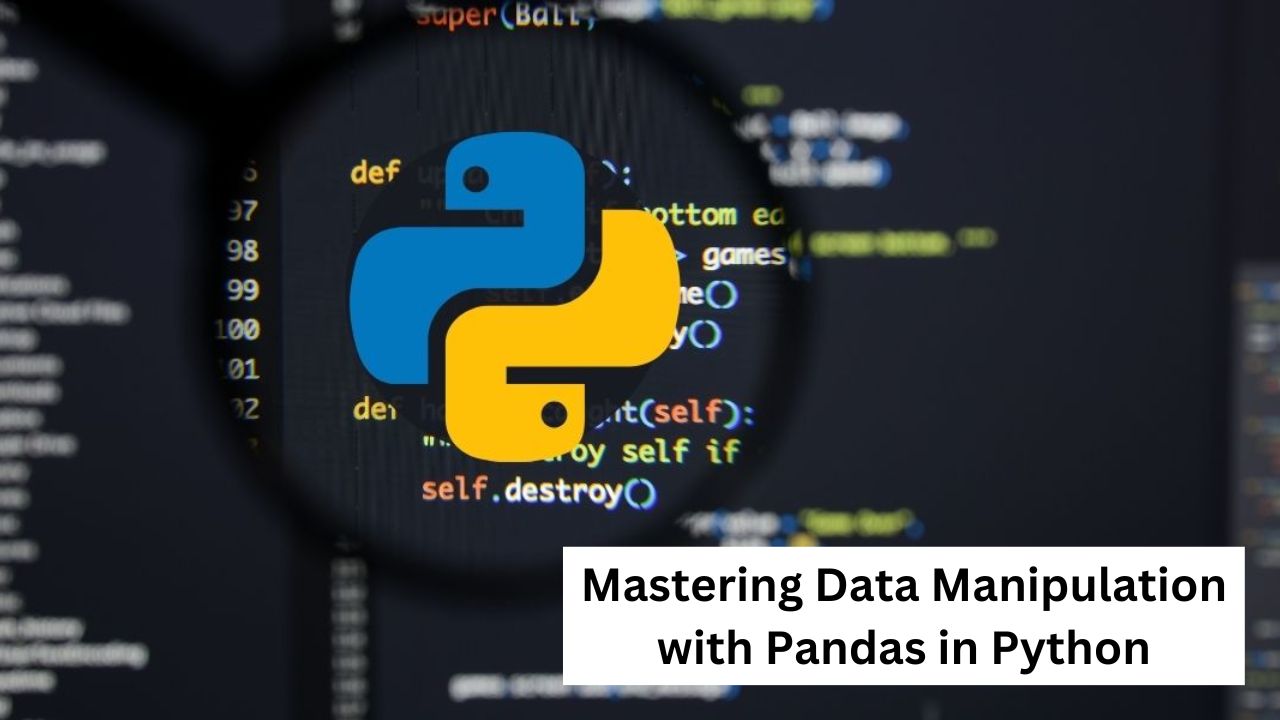Data manipulation is a fundamental aspect of data analysis and plays a crucial role in the field of data science and identifiers in python. In Python, Pandas is the go-to library for data manipulation, offering powerful tools for data cleaning, transformation, and analysis. In this comprehensive guide, we will delve deep into Pandas, exploring its features, functions, and best practices to help you become a Pandas pro.
What is Pandas?
Pandas is an open-source Python library that provides easy-to-use data structures and data analysis tools for working with structured data. Developed by Wes McKinney in 2008, Pandas has since become an essential tool for data scientists, analysts, and researchers.
The two primary data structures in Pandas are Series and DataFrame:
-
Series: A one-dimensional array-like object that can hold any data type. It’s similar to a column in a spreadsheet or a single variable in statistics.
-
DataFrame: A two-dimensional, tabular data structure that consists of rows and columns, much like a spreadsheet or a SQL table.
Installation
Before you can start using Pandas, you need to install it. You can install Pandas using pip, the Python package manager, by running the following command:
pip install pandas
Importing Pandas
Once Pandas is installed, you can import it into your Python code using the import statement:
import pandas as pd
By convention, Pandas is often imported as pd, which makes it easier to reference Pandas functions and objects.
Creating a DataFrame
Data analysis with Pandas usually begins by creating a DataFrame. You can create a DataFrame from various data sources, including dictionaries, lists, NumPy arrays, and external data files (e.g., CSV, Excel, SQL databases). Here’s a simple example of creating a DataFrame from a dictionary:
data = {
'Name': ['Alice', 'Bob', 'Charlie', 'David'],
'Age': [25, 30, 35, 28]
}
df = pd.DataFrame(data)
The resulting df DataFrame will look like this:
Name Age
0 Alice 25
1 Bob 30
2 Charlie 35
3 David 28
Basic Data Operations
Selecting Data
Pandas provides various ways to select data from a DataFrame. You can select specific columns, rows, or a combination of both using methods like loc[], iloc[], and boolean indexing.
- Selecting Columns:
df['Name'] # Selects the 'Name' column
- Selecting Rows:
df.loc[2] # Selects the third row
- Selecting Rows and Columns:
df.loc[1, 'Name'] # Selects the 'Name' of the second row
- Boolean Indexing:
df[df['Age'] > 30] # Selects rows where Age is greater than 30
Data Cleaning
Data cleaning is a crucial step in the data analysis process. Pandas offers various methods to clean and preprocess data, including handling missing values, duplicates, and outliers.
- Handling Missing Values:
df.dropna() # Removes rows with missing values
df.fillna(0) # Replaces missing values with 0
- Removing Duplicates:
df.drop_duplicates() # Removes duplicate rows
- Dealing with Outliers:
Pandas can help you detect and handle outliers in your data using statistical methods and visualization.
Data Transformation
Pandas allows you to perform various data transformations, such as merging and joining DataFrames, reshaping data, and applying functions to columns.
- Merging DataFrames:
df1 = pd.DataFrame({'A': ['A0', 'A1', 'A2'], 'B': ['B0', 'B1', 'B2']})
df2 = pd.DataFrame({'A': ['A3', 'A4', 'A5'], 'B': ['B3', 'B4', 'B5']})
merged_df = pd.concat([df1, df2], ignore_index=True)
- Reshaping Data:
Pandas allows you to pivot, melt, and stack data to fit your analysis needs.
melted_df = pd.melt(df, id_vars=['Name'], value_vars=['Age'], var_name='Attribute', value_name='Value')
- Applying Functions:
You can apply custom functions to DataFrame columns.
df['Age'] = df['Age'].apply(lambda x: x + 2)
Data Analysis
Pandas provides numerous functions for data analysis, including descriptive statistics, groupby operations, and time series analysis.
- Descriptive Statistics:
df.describe() # Generates summary statistics
- Groupby Operations:
grouped = df.groupby('Age').mean() # Groups data by Age and calculates the mean of other columns
- Time Series Analysis:
Pandas is great for working with time series data, allowing for resampling, time-based indexing, and more.
Data Visualization
While Pandas is primarily a data manipulation library, it integrates seamlessly with data visualization libraries like Matplotlib and Seaborn. You can create various plots to visualize your data.
import matplotlib.pyplot as plt
df['Age'].plot(kind='hist', title='Age Distribution')
plt.show()
Advanced Topics
Reading and Writing Data
Pandas can read data from various file formats, such as CSV, Excel, SQL databases, and more. It also allows you to write data back to these formats.
# Reading data
data = pd.read_csv('data.csv')
data = pd.read_excel('data.xlsx')
# Writing data
df.to_csv('output.csv', index=False)
df.to_excel('output.xlsx', index=False)
Performance Optimization
Pandas provides options for optimizing the performance of your data operations. These include using the dtype parameter to specify data types and using vectorized operations to speed up computations.
df['Age'] = df['Age'].astype('int32')
Handling Categorical Data
Pandas allows you to work with categorical data efficiently, which is useful for variables with a limited set of unique values.
df['Category'] = df['Category'].astype('category')
Working with Time Series Data
Pandas offers robust support for time series data, including date-time indexing, resampling, and time-based filtering.
df['Date'] = pd.to_datetime(df['Date'])
df.set_index('Date', inplace=True)
df.resample('D').mean()
Integration with Machine Learning
Pandas seamlessly integrates with popular machine learning libraries like Scikit-Learn and XGBoost. You can prepare your data with Pandas and then train machine learning models using the preprocessed data.
from sklearn.model_selection import train_test_split
from sklearn.linear_model import LogisticRegression
X = df[['
X = df[['Age']]
y = df['Category']
X_train, X_test, y_train, y_test = train_test_split(X, y, test_size=0.2, random_state=42)
model = LogisticRegression()
model.fit(X_train, y_train)
y_pred = model.predict(X_test)
Best Practices and Tips
Here are some best practices and tips for working effectively with Pandas:
-
Use Method Chaining: Method chaining can make your code more readable and concise. Instead of performing multiple operations on different lines, you can chain them together in one line.
pythondf_cleaned = df.dropna().drop_duplicates().reset_index(drop=True) -
Avoid Using
df.copy()Unnecessarily: Pandas DataFrames are mutable, but if you create a copy of a DataFrame usingdf.copy(), it can lead to increased memory consumption. In most cases, you can work with the original DataFrame efficiently. -
Use Vectorized Operations: Pandas is optimized for vectorized operations. Avoid iterating through rows or columns using loops when you can apply a function or operation to an entire column at once.
-
Handling Dates and Times: When working with date and time data, use Pandas’ date-time functionalities to take advantage of powerful time series analysis capabilities.
-
Data Types: Be mindful of data types. Using appropriate data types (e.g., int32, float64, category) can reduce memory usage and improve performance.
-
Documentation and Community: Pandas has extensive documentation and an active user community. When in doubt, consult the documentation or seek help from forums and communities.
-
Profiling Tools: Consider using profiling tools like
pandas-profilingorpandas_summaryto generate in-depth reports on your data, helping you understand your dataset better. -
Keep Code Modular: As your data analysis projects grow, modularize your code by creating functions or classes for common data manipulation tasks. This makes your code more maintainable and reusable.
-
Version Control: Use version control systems like Git to track changes in your Pandas code and collaborate with others effectively.
Conclusion
Pandas is a versatile and powerful library that simplifies data manipulation and analysis in Python. With its easy-to-use data structures, comprehensive data cleaning and transformation capabilities, and seamless integration with data visualization and machine learning libraries, Pandas is an essential tool for data scientists, analysts, and anyone working with structured data.
In this guide, we’ve covered the basics of Pandas, including data manipulation, data cleaning, data transformation, data analysis, and data visualization. We’ve also touched on more advanced topics like reading and writing data, performance optimization, handling categorical data, working with time series data, and integrating Pandas with machine learning libraries.
As you continue your journey with Pandas, remember to explore the extensive Pandas documentation, learn from real-world projects, and practice regularly. Mastery of Pandas can significantly enhance your data analysis skills and enable you to extract valuable insights from data efficiently and effectively.
















